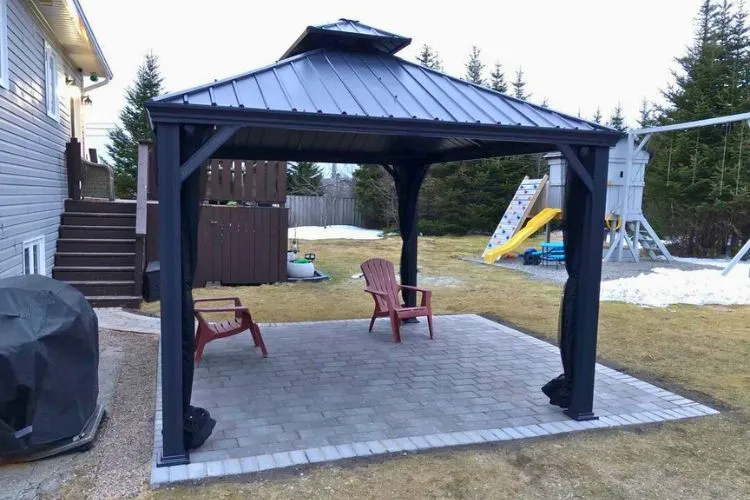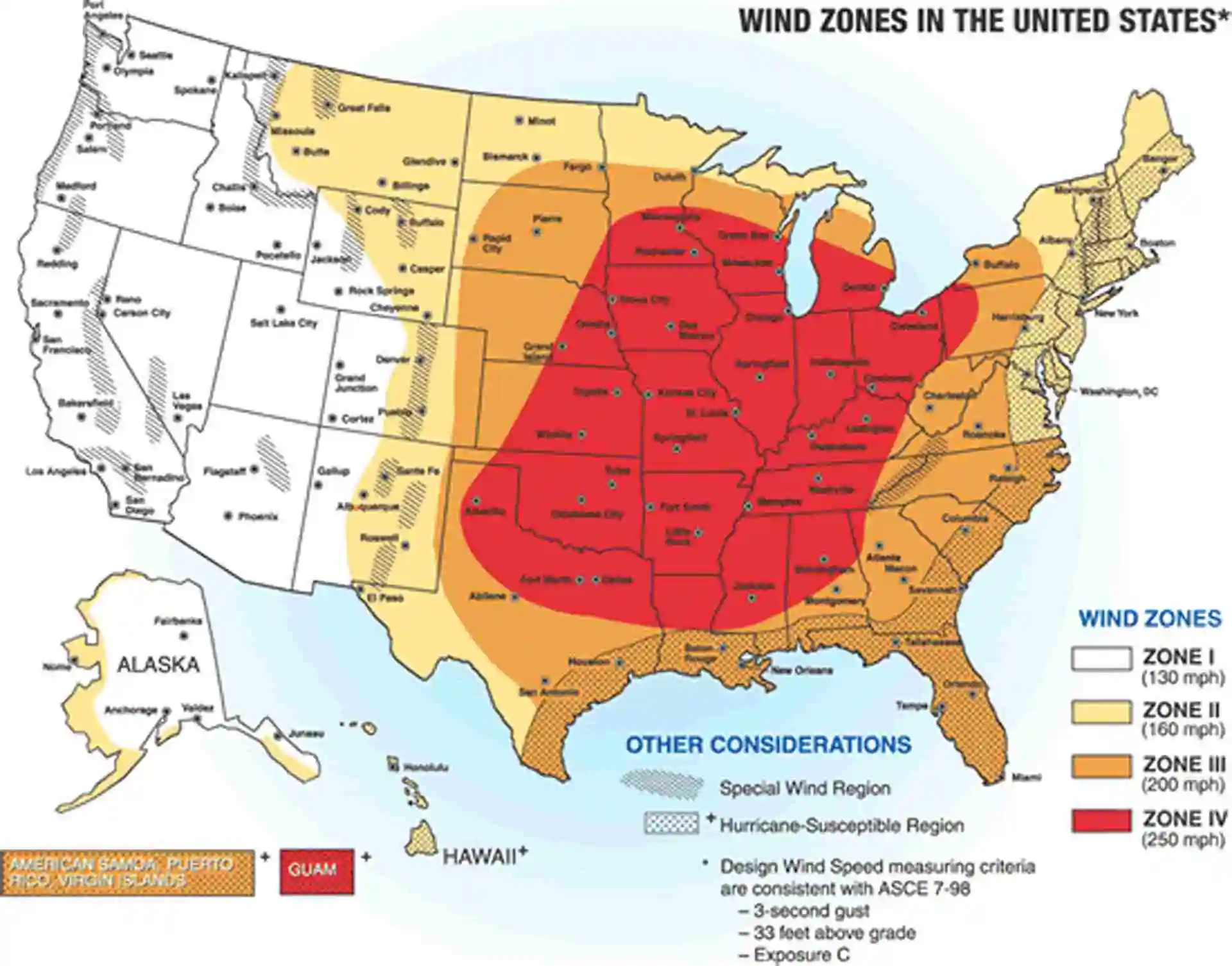Gazebos add charm and functionality to any outdoor space, providing a comfortable shelter for relaxation and gatherings. However, the tranquility provided by these elegant structures can quickly turn into concern when faced with the challenge of high winds.
It’s therefore essential to learn how to secure a gazebo from wind, not just to prolong its life but to ensure safety. This guide delves into various methods and best practices for safeguarding your gazebo against gusty conditions.

Contents
- 1 Understanding the Risks of Wind to Your Gazebo
- 2 How To Secure A Gazebo From Wind Different Methods?
- 3 Do’s and Don’ts of Windproofing Your Gazebo
- 4 Maintenance Tips for a Wind-Resistant Gazebo
- 5 Understanding Wind Zones: A Guide for Gazebo Windproofing
- 6 What is a Wind Zone Map?
- 7 How to Use a Wind Zone Map for Gazebo Windproofing?
- 8 Benefits of Using a Wind Zone Map
- 9 Frequently Asked Questions (FAQs)
Understanding the Risks of Wind to Your Gazebo
Gazebos, with their open design and lightweight framework, are inherently vulnerable to the forces of wind. High winds can exert a lifting force on the gazebo canopy, lead to structural twisting, and in severe cases, cause uplift or complete detachment from the ground.

The degree of risk largely depends on the gazebo’s material, size, design, and anchoring system. Recognizing these risks is the first step in implementing robust protection strategies.
How To Secure A Gazebo From Wind Different Methods?
One of the most reliable methods to secure a gazebo is using anchor kits and stakes, designed specifically for this purpose. These anchoring systems work by providing a firm hold in the ground, making it difficult for the wind to uproot the gazebo.
Metal stakes are driven deep into the soil, ensuring stability against wind uplift. The effectiveness of this method, however, largely depends on the soil’s type and the correct installation of the stakes.

Leg Weights and Sandbags
For gazebos installed on harder surfaces where stakes cannot be used, leg weights and sandbags offer an excellent solution. These weights act as ballasts, increasing the gazebo’s overall weight and reducing the chance of movement.
While leg weights are specifically designed for this purpose, providing a clean and convenient option, sandbags can be a cost-effective DIY alternative. The key here is to ensure an adequate amount of weight is evenly distributed on each leg of the gazebo.
Tie Down Strategies
Tie-downs, involving ropes or straps, offer additional security against wind. These are tied from the gazebo to ground anchors or sturdy points in your yard, creating a tension that helps hold the gazebo down.
Selecting the right material is crucial, as ropes and straps need to be strong enough to withstand wind forces without causing damage to the gazebo.
Securing to a Permanent Structure
When possible, anchoring your gazebo to a permanent structure like a deck or concrete pad can significantly enhance its resistance to wind.
This method often involves bolting the gazebo directly to the structure, providing a level of security that portable methods cannot match. It is essential to ensure that the structure itself is capable of withstanding the added stress from wind forces.
Using Gazebo Weights and Planters
Integrating gazebo weights and decorative planters can serve dual purposes—enhancing aesthetics while providing the necessary anchoring.
Weights designed to fit aesthetically with the gazebo or custom planters filled with soil or sand can be placed at the corners, offering a more visually appealing solution without compromising on functionality.
You may also find useful: How To Keep Water From Pooling On Gazebo? Expert Tips & Tricks
Do’s and Don’ts of Windproofing Your Gazebo
Windproofing your gazebo efficiently requires adhering to a set of do’s and don’ts. It’s critical to always follow the manufacturer’s instructions for installation and securing methods.

Regular inspections for wear and tear, especially before storm seasons, can help identify potential issues early. However, avoid cutting corners with makeshift anchoring methods that have not been proven effective, as these can compromise the structure’s integrity and safety.
Maintenance Tips for a Wind-Resistant Gazebo
Maintaining a gazebo so it remains resistant to wind involves regular checks and upkeep. Loose bolts should be tightened and worn-out anchoring equipment replaced promptly.
Moreover, understanding seasonal wind patterns and preparing your gazebo accordingly can prevent sudden and unexpected damage. For regions experiencing severe weather, considering seasonal dismantling and storage might be the best course of action to prolong the lifespan of the gazebo.
Understanding Wind Zones: A Guide for Gazebo Windproofing
When it comes to securing a gazebo against the wind, one size does not fit all. The geographic location of your gazebo plays a crucial role in determining the kind of windproofing measures you’ll need to implement.
This is because different regions are subjected to varying levels of wind speeds and patterns, primarily due to their topography, altitude, and proximity to the coast. To aid in this understanding and preparation, incorporating a Wind Zone Map into your planning process can be immensely beneficial.
What is a Wind Zone Map?
A Wind Zone Map is a visual representation that categorizes different areas based on the average wind speed or the potential for high winds, including storms and hurricanes.

These maps are often color-coded and segmented into zones to easily identify the wind risk level associated with specific geographical locations. They take into account historical data, including the frequency and intensity of wind-related events, to provide a guideline on what to expect in terms of wind.
How to Use a Wind Zone Map for Gazebo Windproofing?
- Identify Your Zone: The first step is to locate your geographic area on the Wind Zone Map. This will inform you of the wind zone your property falls into, which is indicative of the average wind speeds you can expect.
- Understand Zone Specifications: Each wind zone comes with specific characteristics. For example, zones closer to the coast might not only have higher wind speeds but also a higher likelihood of encountering hurricanes. In contrast, inland zones might have lower average wind speeds but could experience sudden gusts due to storms.
- Choose Appropriate Windproofing Measures: Once you know your wind zone, you can make informed decisions about the type of windproofing measures suitable for your gazebo. Higher-risk zones may require more robust solutions, such as deep-ground anchors and permanent structures, while lower-risk zones might be well-served with leg weights and sandbags.
- Plan for Seasonal Adjustments: Wind patterns can change seasonally, and some areas might face increased wind risks at certain times of the year. Knowing your wind zone can help you prepare for these seasonal changes ahead of time, perhaps by reinforcing your gazebo’s anchoring system or planning for temporary dismantling during high-risk periods.
- Compliance and Permitting: In areas with high wind speeds or frequent storms, local building codes may have specific requirements for outdoor structures, including gazebos. Referencing your wind zone can aid in ensuring that your windproofing measures comply with these regulations, potentially requiring permits or inspections.
Benefits of Using a Wind Zone Map
- Customized Protection: By understanding the wind risks specific to your location, you can tailor your gazebo’s windproofing measures to provide effective protection without over or under-preparing.
- Cost Efficiency: Knowing your exact needs can prevent overspending on unnecessary windproofing techniques or facing costly repairs due to inadequate preparation.
- Safety Assurance: Proper preparation based on accurate wind zone information can significantly enhance the safety of your gazebo and its users, preventing accidents and injuries related to wind damage.
Incorporating a Wind Zone Map into your gazebo windproofing strategy adds a layer of precision and customization to your efforts, ensuring that your gazebo can stand resiliently against the winds it’s most likely to face.
By taking the time to understand your wind zone and applying the relevant windproofing measures, you can enjoy your gazebo with peace of mind, knowing it’s well-secured against the elements.
Frequently Asked Questions (FAQs)
Should I open or close the canvas walls in strong winds?
It is generally advisable to open canvas walls during strong winds. Closed walls can act like sails, catching more wind and increasing the likelihood of damage. Removing side panels or ensuring they are not creating additional resistance is a good practice in windy conditions.
How to choose the best gazebo for wind-prone areas?
When selecting a gazebo for wind-prone areas, opt for models designed with wind resistance in mind. These can include features like vented tops, which allow wind to pass through, reducing uplift, and sturdier frames made from metal or heavy-duty wood. It’s also important to consider the ease of anchoring and whether the model comes with any windproofing accessories.
Can I use natural barriers for wind protection?
Yes, natural barriers such as hedges, trees, or strategically placed walls can provide significant wind protection for your gazebo. These barriers can help to deflect or minimize wind speeds around the gazebo area. However, their effectiveness will vary based on the types of barriers and their placement relative to prevailing winds.
How to tell if extra windproofing is necessary?
Indicators that your gazebo may need extra windproofing include visible movement during moderate winds, signs of stress on anchoring points, or any history of uplift. It’s always better to err on the side of caution and reinforce your gazebo’s windproofing measures before strong winds cause damage.
Conclusion:
Securing your gazebo against the wind is essential for ensuring its longevity and maintaining the safety and comfort of its users.
By employing effective anchoring methods, adhering to best practices, and performing regular maintenance, you can enjoy your outdoor oasis even when the weather turns windy. The key is to be proactive and prepared, ensuring your gazebo remains a steadfast feature of your outdoor living space.

Sergio Gomes, a passionate advocate for outdoor living and the male voice behind Shades Authority. With years of experience, Sergio is your trusted source for expert insights on gazebos, pavilions, cabanas, pergolas, and all things outdoor shade solutions. Join him on a journey to transform your outdoor spaces into stunning, functional retreats
